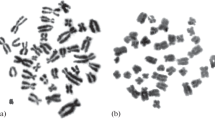Summary
Karyotypes have been studied in 3 species ofHynobius and in 1 species each of the remaining genera of Hynobiids (Ranodon, Batrachuperus, Salamandrella andOnychodactylus). All species have large diploid numbers, between 56 and 66, and asymmetrical and bimodal karyotypes. DNA contents (2C) were found to vary between 33 and 51 pg. Determination was not possible inOnychodactylus where higher values may be suspected. Some of the karyotypes investigated are similar to those of Cryptobranchids. Phylogenetic implications are discussed.
Similar content being viewed by others
References
G.K. Noble, The Biology of the Amphibia. Mc Graw-Hill, Mainhead 1931.
R. Estes, Am. Zool.5, 319 (1965); P.J. Regal, Evolution20, 392 (1966); J.J. Edwards, J. Morph.148, 305 (1976).
I.I. Schmalhausen, in: The Origin of Terrestrial Vertebrates. Academic Press, New York and London 1968.
A.G. Bannikov, Zool. Jb.83, 245 (1958).
R. Thorn, in: Les Salamandres. P. Lechevalier, Paris 1968.
S. Makino, J. Fac. Sci. Hokkaido Univ.2, 97 (1932); Trans. Sapporo nat. Hist. Soc.13, 351 (1934).
I. Sato, J. Sci. Hiroshima Univ.B 4, 144 (1936).
J. Azumi and M. Sasaki, Chromos. Inf. Serv. Hokkaido Univ.12, 31 (1971).
A. Morescalchi, in: Cytotaxonomy and Vertebrate Evolution, p. 233. Eds. A.B. Chiarelli and E. Capanna. Academic Press, London 1973.
A. Morescalchi, Evol. Biol.8, 339 (1975).
We owe the chance to study these rare and precious animals to the interest of various Herpetologists. In detail, we wish to thank most sincerely Robert Thorn (Luxembourg), Prof. J.S. Darevsky (Academy of Sciences, Leningrad) and Dr M. Kuramoto (Fukuoka University).
A. Morescalchi, G. Odierna and E. Olmo, Experientia33, 1579 (1977).
G.L. Stebbins, Chromosomal Evolution in Higher Plants. Edward Arnold, London 1971.
R. Matthey, Les Chromosomes des Vertébrés. F. Rouge, Lausanne 1949.
Author information
Authors and Affiliations
Additional information
Research supported by a grant from the Ministero della Pubblica Istruzione.
Rights and permissions
About this article
Cite this article
Morescalchi, A., Odierna, G. & Olmo, E. Karyology of the primitive slamanders, family hynobiidae. Experientia 35, 1434–1436 (1979). https://doi.org/10.1007/BF01962768
Issue Date:
DOI: https://doi.org/10.1007/BF01962768




